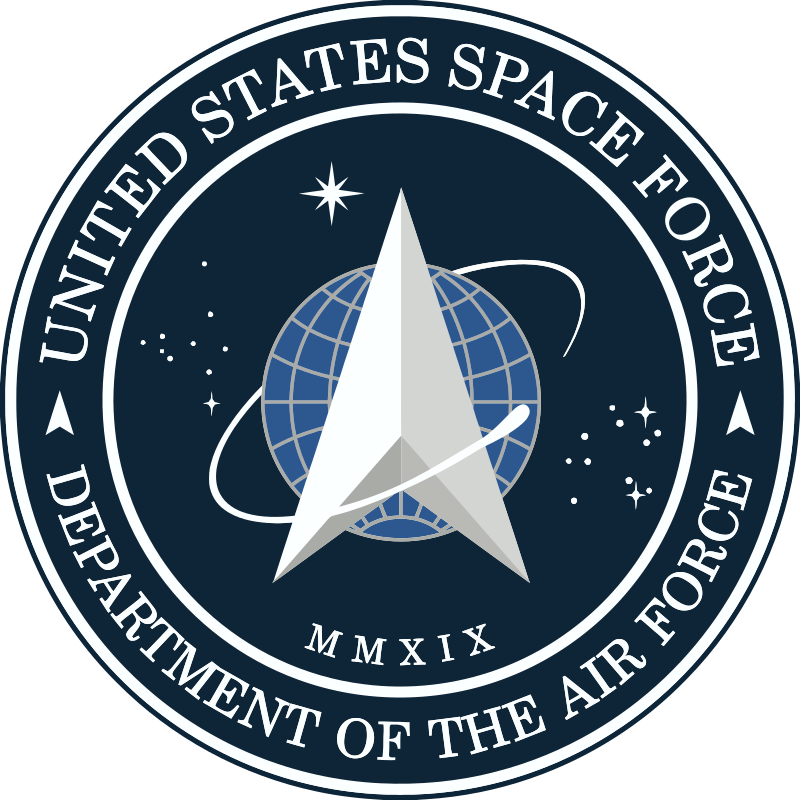“Given the overall use of the two marks, the fictional nature of the Starfleet logo, and the lack of intent, one has a hard time believing any court would find infringement.”
 On January 24, 2020, the United States Space Force logo hit the news — and the photon torpedoes began to fly. Almost instantly, those familiar with the Star Trek Starfleet Command insignia called out a striking similarity, and even George Takei (who played USS Enterprise helmsman Hikaru Sulu) tweeted “Ahem. We are expecting some royalties from this…”
On January 24, 2020, the United States Space Force logo hit the news — and the photon torpedoes began to fly. Almost instantly, those familiar with the Star Trek Starfleet Command insignia called out a striking similarity, and even George Takei (who played USS Enterprise helmsman Hikaru Sulu) tweeted “Ahem. We are expecting some royalties from this…”
Putting aside the actual origin of the Space Force insignia (derived from the Air Force Space Command emblem), could someone actually claim that the Space Force emblem constitutes trademark infringement on the Star Trek logo?
Real Versus Fictional Clean Slates
Let’s start by looking to the Seventh Circuit case of Fortres Grand against Warner Brothers, which dealt with another variant of the overlap between fiction and reality. As you may recall, in the film The Dark Knight Rises, Catwoman wants to erase her criminal history from every database in the world, giving her the chance to return to a normal life. The perfect tool is “the clean slate,” a database hacking program by the Rykin Data Corporation. Rykin itself was fictional, as was the software, but real-world corporation Fortres Grand actually was marketing a Clean Slate software to erase user activity from public access computers.
Fortres Grand filed suit against Warner Brothers for trademark infringement, and on its appeal to the Seventh Circuit Court of Appeals alleged “reverse confusion.” Fortres claimed that consumers would find Warner Brothers’ use of the name “clean slate” confusing, leading them to believe that the real-world software was connected with the film company. The Seventh Circuit Court of Appeals thought otherwise, writing “[w]hoever these unusually gullible hypothetical consumers are, Fortres Grand has not and could not plausibly allege that consumers are confused into thinking Fortres Grand is selling such a diabolical hacking tool licensed by Warner Bros.” Fortres Grand Corp. v. Warner Bros. Ent. Inc., 763 F.3d 696, 705 (7th Cir. 2014).
Considering the fictional nature of the software and the fact that the term was used only descriptively in film dialogue, the court found in favor of Warner Brothers. In balancing a fictional product with a real-world offering, the court stated “[t]rademark law protects the source-denoting function of words used in conjunction with goods and services in the marketplace, not the words themselves.” As Warner Brothers did not offer any actual service, and other factors considered in trademark infringement weren’t strong enough to move the needle, there was no trademark infringement.
The Seven-Factor Test
So, what about Space Force v. Starfleet? Let’s look at the seven-factor test the court used in Fortres Grand:
- the degree of similarity between the marks in appearance and suggestion. Do the two marks appear similar? Certainly. Regardless of the emblems’ respective histories, there certainly is a confluence of components and arrangement.
- the similarity of the products for which the name is used. The Space Force “organizes, trains, and equips space forces in order to protect U.S. and allied interests in space and to provide space capabilities to the joint force. USSF responsibilities include developing military space professionals, acquiring military space systems, maturing the military doctrine for space power, and organizing space forces to present to our Combatant Commands.” The Star Trek emblem, in our real world, may be used to sell certain commercial products, but does not actually provide services related to military space systems, protection of the space domain, or boldly going anywhere off planet Earth.
- the area and manner of concurrent use. The Space Force does not only offer the services above. As part of uniform development (and perhaps brand marketing), it will offer articles of clothing, patches, “branded” gear for its members and the public, and perhaps even toys and games. (Visit a local military base PX, and you’ll see all of these available related to local units and missions.) Given these offerings in the real-world marketplace, the overlap becomes a bit clearer.
- the degree of care likely to be exercised by consumers. Are consumers careful in selecting who delivers space combat power? Perhaps. In buying cool space-related or Star Trek gear? Maybe not so much. One can easily imagine the accidental gifting of a Star Trek hat to the teenager prepping to head off to Space Force basic training.
- the strength [or “distinctiveness”] of the complainant’s mark. The Space Force logo is brand new, while the Star Trek symbol (or its variants) have been in the public eye since the television show launch in 1966. Is the Starfleet logo distinctive? Certainly so.
- actual confusion. With the Space Force logo being brand new, there likely is no actual confusion yet. Only time will tell how many of those accidental gifts get given this year.
- an intent on the part of the alleged infringer to palm off his products as those of another. While some have cried foul, and others have alleged laziness, arguments that the Space Force is trying to be perceived as a Starfleet offering are unlikely.
Space Force Logo Trumps Fiction
So, does the new logo infringe when viewed through a trademark analysis? Unlikely. Given the overall use of the two marks, the fictional nature of the Starfleet logo, and the lack of intent, one has a hard time believing any court would find infringement. That said, the Space Force trademark defense may not be as strong as transparent aluminum — only time will tell (unless, of course, George Takei takes us on a slingshot maneuver around the sun).

![[IPWatchdog Logo]](https://ipwatchdog.com/wp-content/themes/IPWatchdog%20-%202023/assets/images/temp/logo-small@2x.png)

![[Advertisement]](https://ipwatchdog.com/wp-content/uploads/2024/04/Patent-Litigation-Masters-2024-sidebar-early-bird-ends-Apr-21-last-chance-700x500-1.jpg)

![[Advertisement]](https://ipwatchdog.com/wp-content/uploads/2021/12/WEBINAR-336-x-280-px.png)
![[Advertisement]](https://ipwatchdog.com/wp-content/uploads/2021/12/2021-Patent-Practice-on-Demand-recorded-Feb-2021-336-x-280.jpg)
![[Advertisement]](https://ipwatchdog.com/wp-content/uploads/2021/12/Ad-4-The-Invent-Patent-System™.png)






Join the Discussion
5 comments so far.
RevDrJBDTDDPhD
May 17, 2020 08:43 pmBoth the NASA “Meatball” Logo and the USAF “SAC Division” (Later to become the Air Force Space Command in the 1980’s) Logos , May have been the “Inspiration” for the “Star Trek” art department back in the 1960’s.
DC
February 18, 2020 04:03 pmThe Galaxy Quest logo would have been a better match for the Space Force.
domain guy
February 16, 2020 02:11 pmso the logo was in use since 1964 and it is owned by paramount or was when I cked it last. And yes there could be infringement because there is a star trek fan club that uses its logo and in commerce at the star trek meetings. treekes a world wide organization
Mark S Nowotarski
February 15, 2020 08:26 am“arguments that the Space Force is trying to be perceived as a Starfleet offering are unlikely.”
I’m not so sure about that. I think that this is exactly what the administration is trying to do, have Space Force be perceived as a Starfleet offering. Recall how the Strategic Defense Initiative of the 1980’s were referred to as the (albeit derisively) “Star Wars” program.
Mark Ciotola
February 14, 2020 01:06 pmPerhaps both are a ripoff of the NASA meatball logo which predated both.